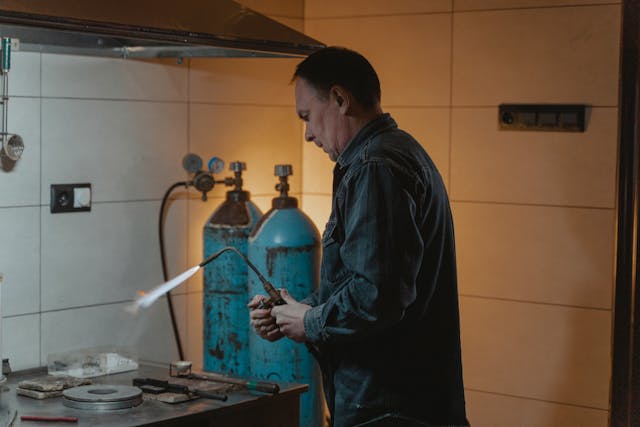
Why does an oxyacetylene torch get so hot? An oxyacetylene torch gets so hot because the particles in acetylene hold an enormous amount of energy that they release when they are exposed to oxygen.
Most of us will never have used an oxyacetylene torch. They are used by metal workers to weld or to cut metal. An oxyacetylene torch can reach temperatures of 3,500 ℃, which is more than enough to cut through many types of metal, but it can’t cut through all metals. We’ll look at why a little later.
To make a fire you need fuel, oxygen, and a heat source. This is known as the fire triangle. If you want to extinguish a fire, all you have to do is remove one of these three things. Not every fuel will burn. The fuel needs to have molecules that will react with oxygen molecules. Ceramic, for example, won’t burn because there are no molecules that will react with oxygen. When you light a fire, a chemical reaction happens that produces heat. This is called combustion. When there is no heat source, the fuel and the oxygen just sit next to each other, perfectly happily. Once you add heat and the fuel gets warmer, the molecules start to combine with the oxygen molecules in the air. Each time an oxygen molecule combines with a molecule from the fuel, they make a new molecule and the resultant molecule has less energy than the two individual atoms had before. This excess energy is released as heat and light. And that is a fire. The temperature of the fire is dictated by the amount of energy the molecules can release when they combine with oxygen. The more energy they have originally, the more energy will be released when they combine with oxygen, and the hotter the fire will be.
A basic wood fire will burn at between 300 ℃ and 950 ℃, depending on the type of wood. You cannot make wood burn hotter than that because that is the upper limit to the amount of energy stored in the wood. Coal will burn at a higher temperature because it has more energy stored. A coal fire burns at about 1000 ℃, but it can reach 1700 ℃. The way to make it burn hotter is to supply more oxygen. If you use a bellows, you can introduce more oxygen into the equation and more molecules can react. You can’t change the amount of energy the coal has stored, but you can increase the number of molecules that are combining with oxygen at any one time. And this is the reason why an oxyacetylene torch can get so hot.
Acetylene is a gas that is made of two carbon atoms and two hydrogen atoms. Each carbon atom has four electrons and each hydrogen atom has two electrons, for a total of 10 electrons. When the acetylene combines with oxygen, it produces carbon monoxide and hydrogen. These molecules need far fewer electrons than the original acetylene and all of this energy is released as heat. So much energy is released that the flame is far hotter than a regular fire. The acetylene is kept in a pressurized tank and next to it is a tank of pressurized oxygen. Both gases are forced out of the nozzle and combined. This mixes far more oxygen into the acetylene, making the flame much hotter. It can reach temperatures of 3,500 ℃.
Oxyacetylene torches have many uses, but they can also be used underwater because they have their oxygen supply with them. A fire will not burn underwater because there is no oxygen, but an oxyacetylene torch will. One problem with the torches, though, is that there are some metals they can’t cut. When you use an oxyacetylene torch to cut metal, two things are happening. The first is that the oxygen and acetylene are combing to make a very hot flame. The second is that the very hot flame is heating the metal so much that it starts to oxidize. The molecules in the metal combine with the oxygen coming from the torch and they produce even more energy and even more heat, cutting the metal. This doesn’t work for metals like stainless steel because they are designed not to oxidize. This is why they don’t rust. An oxyacetylene torch can melt them, but it can’t cleanly cut them And this is what I learned today.
Sources
https://en.wikipedia.org/wiki/Oxy-fuel_welding_and_cutting
https://en.wikipedia.org/wiki/Acetylene
https://www.sciencedirect.com/topics/engineering/oxyacetylene-torch
https://www.bbc.co.uk/bitesize/articles/zcwxcj6#zdxjdp3
https://www.qrg.northwestern.edu/projects/vss/docs/Propulsion/2-how-do-things-burn.html
https://coalpail.com/coal-forum/viewtopic.php?t=488
Photo by Tima Miroshnichenko: https://www.pexels.com/photo/man-in-blue-long-sleeve-shirt-using-an-acetylene-torch-6263144/
